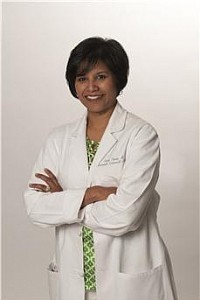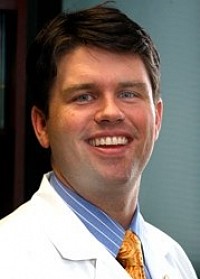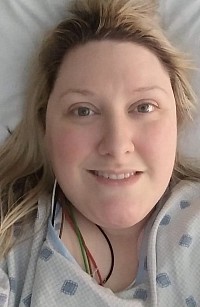My Story
My journey began on January 25, 2010. I had been practicing yoga and pilates faithfully for months and was really feeling great. After my workout on this particular night, I noticed my back beginning to hurt. I thought that perhaps I had pulled a muscle, so I took some over-the-counter pain medication and went to bed. The next morning, my back was in so much pain that my mother took me to the emergency room. I wondered if I may have kidney stones. The doctors gave me some IV pain medication and did several tests including CT scans, ultrasounds, and x-rays. All of the tests came back negative, indicating no obvious issues. It was unsettling to not find the cause of my extreme pain.
I followed up with my primary care physician, who sent me to a urologist for a work-up. I was less than thrilled with the treatment I received from the urologist. He did urine tests and found that I had microscopic blood in my urine. Instead of investigating further, he simply said that he "figured that was normal for me". Unsatisfied with the lack of attention the doctor was giving my case, I pressed him to perform further testing. I knew that there was something wrong with me and I was not going to be brushed off or take no for an answer. The doctor relented and said he would do a ureteroscopy. The test would tell us if I had any kidney stones that did not show up on my previous scans. The procedure went smoothly, but it did not reveal any stones or other problems. That same night, I began having terrible pain in my back again. My mother called the urologist, concerned it may be the result of the procedure earlier in the day. He was unconcerned and told her that "he did not find anything, so I guess just take her to the ER". I was supposed to have a follow up with the urologist, but I canceled it and never went back. I know that doctors can sometimes be intimidating, but they are there to serve you, not the other way around. Trust your instincts, because you know your body better than anyone.
I decided that my next step should be to find an internal medicine specialist. I found a clinic and made an appointment with one of the doctors. She set up several tests which included ultrasounds of my urinary and reproductive systems. There were also blood tests and urine tests. Once again, the tests came back negative, showing no problems. I went to this doctor for about three months. It became clear that she was out of ideas and not very interested in pursuing my case. So once again, I moved on. I was determined to find out what was wrong.
I have an amazing mother and aunt who have always loved and supported me unconditionally. I was grateful, now more than ever, to have them in my corner and by my side through this entire ordeal. It can become very discouraging when you are told time and again that nothing is wrong, when you know different. I continued to have to go to the ER on a regular basis for the extreme pain I was experiencing in my back.
I live in Little Rock, Arkansas and we have access to a world-class teaching hospital, University of Arkansas for Medical Sciences, or UAMS. I thought that this might be a good next step for me, so I made an appointment with one of their internal medicine doctors. The doctor I saw was very nice and did several tests, including sending me to have a colonoscopy done there at the hospital. I was also referred to a gynecologist for a work-up. Once again, no issues were found. It was like a double-edged sword every time I was given test results. I was certainly glad that nothing catastrophic was wrong with me, but I knew there was still something there that was not being found. I had various blood and urine tests run, and on my next appointment, my doctor said that he did find that I was severely deficient in Vitamin D. I was put on some high-powered vitamins to get my levels back up. Beyond that, he was also running out of ideas.
One night when I was having terrible pain, my mother called the after-hours number for the Internal Medicine clinic. When my pain escalates, I have difficulty communicating, so my mother helps me by speaking to the doctors and nurses on my behalf. As fate would have it, the doctor on call that night was Dr. Sara Tariq. She is one of the doctors in the I.M. clinic at UAMS and is widely acknowledged as being one of the best. She is so popular that she rarely accepts new patients. My mom was really impressed with her caring nature and interest in me. She asked Dr. Tariq if she would consider becoming my doctor. Thankfully, she agreed and I felt a sense of renewed hope. She set me up with a gastroenterologist who performed an Esophagogastroduodenoscopy, or EGD, which is a procedure where the patient is sedated and a scope is run down the throat in order to examine the esophogus, digestive tract and stomach. Once more, nothing out of the ordinary was found.
My next appointment was with a new gynecologist, who happened to be a friend of Dr. Tariq. I felt comfortable with Dr. Brian Burton right away. After an examination which was normal, he suggested that we check for endometriosis. Unfortunately, the only way to do this is through surgery. I was willing to do anything to get the answers I so desperately needed. We set up the appointment for the laparoscopy, and crossed our fingers. I knew from experience, having had my gallbladder removed laparoscopically when I was 18, that these kinds of procedures were fairly quick and easy to recover from. I was anxious for the results, but I wasn't scared. During the surgery, the doctors decided to remove my appendix also. It was a smart move since they were already there, and it would eliminate having any problems with it down the road. It also served to exclude the appendix as the source of my problems. Upon waking, I learned that there was no endometriosis. Yet again, I was happy to not have anything horribly wrong, but I was exasperated to not have an answer. I tried to look at things positively. We had eliminated the possibility of my problem being gynecologically related. I had also found a really good gynecologist that I trusted and would keep as my doctor.
Dr. Tariq then referred me to the Pain clinic at UAMS to see if there was anything they could do for me. I tried different things such as nerve blocks to see if that would help or eliminate the pain. When that did not work, we tried implanting a trial version of a spinal cord stimulator. I prayed this would work, but tried not to get my hopes up. Spinal cord stimulators are supposed to interrupt the pain signal and replace it with a vibrating sensation. I did feel the vibration, but I still had the pain. We also tried muscle relaxers, pain patches, among other pain medications. The only medication that seemed to work was the Dilaudid I was given in the ER. At this point, I had been to the ER so many times, it was like the Cheers bar - everyone knew my name. I have encountered so many wonderful doctors and nurses. Unfortunately, there are bad ones in every bunch. On two separate occasions in the emergency room, I was seen by a doctor who literally called me a drug addict and said there was nothing wrong with me. My mother, who has always been the one to take me to the hospital, was enraged. She knew as I did, that there was something wrong.
I realize that emergency room doctors see their fair share of patients who are drug seekers. It is the task and responsibility of the doctor to fully assess the patient, read over their chart and decide on the best course of action. Doctors who rush to judgment and do not perform their due diligence are dangerous. Making negligent assumptions in the emergency room can result in the death of the person entrusted to their care.
Dr. Tariq is not one to give up, but we were at a point where we needed some help. It was then that she referred me to The Mayo Clinic in Rochester, MN. I had always heard of the illustrious reputation of Mayo Clinic, as being one of the best medical facilities in the world. Dr. Tariq made the referral for me and my mother and I began planning for our trip to Minnesota.
One concern for us was the cost. As my condition worsened, it became impossible for me to continue working. I was in and out of the hospital, and also on pain medication that made concentration very difficult. So, in a household where my mother and I pooled our salaries and split the expenses, the loss of half of our income was devastating. I knew that we had to save money wherever we could, so I began an internet search for any charity or assistance available to help patients with airfare cost associated with traveling for medical reasons. You have to be very careful because there are always going to be people out there just waiting to rip you off. Naturally, I was leary at first when I discovered the website for Mercy Medical Airlift. I did some investigating and found that they were genuine. They take donations of airline miles and money in order to help people like me who need medical care, but have to travel some distance to get there. It was an absolute blessing. I was so humbled and deeply appreciative to everyone at MMA who helped us. I have a link to their website on my Helpful Links page, or you can click here to learn more.
After months of preparation and planning, in January of 2011, we were on our way to Minnesota. It had now been a year since my symptoms first started. My family and I prayed that this trip would give us some answers. Walking into the Mayo Clinic for the first time was incredible to say the least. Being January in Minnesota, it was snowing to beat the band. It was, however, quite beautiful to watch the flakes fall from the lobby of the Gonda Building. It has huge windows that let in incredible amounts of light, and there is always someone playing the grand piano which echoes off of the tile floors and tall ceilings. There are beautiful works of art everywhere you look. It is clear that every measure has been taken to make the patients feel welcome and comfortable, despite whatever circumstances that make their visit necessary. Due to the harsh Minnesota winters, there are underground tunnels that connect several of the buildings on campus as well as others in the downtown area. It was so convenient that there were underground hallways which connected our hotel, The Kahler Grand Hotel, to the Mayo Clinic. It is just across the street, so luckily it was not far to walk. There were shops and restaurants in the hallways as well. It was a nice distraction to be able to look through the shops or grab a bite to eat between appointments. Everyone we encountered from the hotel staff, the waiters in the restaurants, or just complete strangers you passed, were all so incredibly kind and willing to help in any way they could.
It is truly astonishing how much you can accomplish in one day at Mayo. It is possible to have several doctor appointments and tests in one day. Once you have completed a test, it is not long at all before you can access your results on the Mayo website. During my two week stay, I was able to have more done than I could in six months back home. In that time, I had a primary doctor overseeing my care, a gastroenterologist, a urologist, a psychiatrist and a nephrologist. I had so many tests ranging from nerve conduction studies, blood work, urine tests, another ureteroscopy, CT scans of my entire body, x-rays, nuclear studies on my digestive system, psychological evaluation, and finally a kidney biopsy. I felt like a lab rat, but I was pleased that they were being so thorough. The nephrologist was the last doctor I saw. I had never been referred to a kidney specialist and I insisted that the primary doctor set up an appointment. Through my entire ordeal, my pain was consistently in the same place - over my kidneys in my back. In the back of my mind, I always wondered if my problem was kidney-related.
Dr. Marie Hogan, the nephrologist to which I was referred, is originally from Ireland. She was surprised to learn that this was my first visit to a kidney specialist. She listened to my story and said that my symptoms sounded a bit like LPHS, but that she wanted to perform a kidney biopsy to be sure. I had never heard of this illness before, so as soon as my mom and I left the appointment we headed straight for one of the clinic's public computers to do some research. Everything I read about LPHS made so much sense. I remember saying to my mom that the information on LPHS was so close to what I had been going through and that this may finally be our answer. I didn't want to get too excited, having been disappointed many times before. The procedure itself did not take long, but I had to be in recovery for a while. The patient must lie on their back for four hours with minimal movement to ensure that the kidney is able to heal and avoid any bleeding from the kidney, which could be very dangerous. I had to also stay close to the hospital for 24 hours, just as a precaution. Two days after the biopsy, we headed for home. The results would take several days to come back and we really needed to get home. Leaving Minnesota without an answer was heart-breaking.
A couple of days after returning home, we received a call from Dr. Hogan. I was impressed that she was the one who called instead of a nurse or technician. She delivered the news that we had suspected. I was diagnosed with Thin Basement Membrane Disease and LPHS. She gave us as much information on the disease as she could and explained that there is not yet a cure available. My first reaction was immense relief. I finally had a diagnosis. I wasn't crazy. I knew that we had a long road ahead, but now we knew what we were up against. During that year of searching, my mind drifted to all of the worst case scenario diagnoses. I was relieved that the condition was not fatal. Sometimes when I am feeling my worst, I try to remember that there are always others who are worse off than I am. It is then that I count my blessings, namely my family and friends who are so very dear to me.






